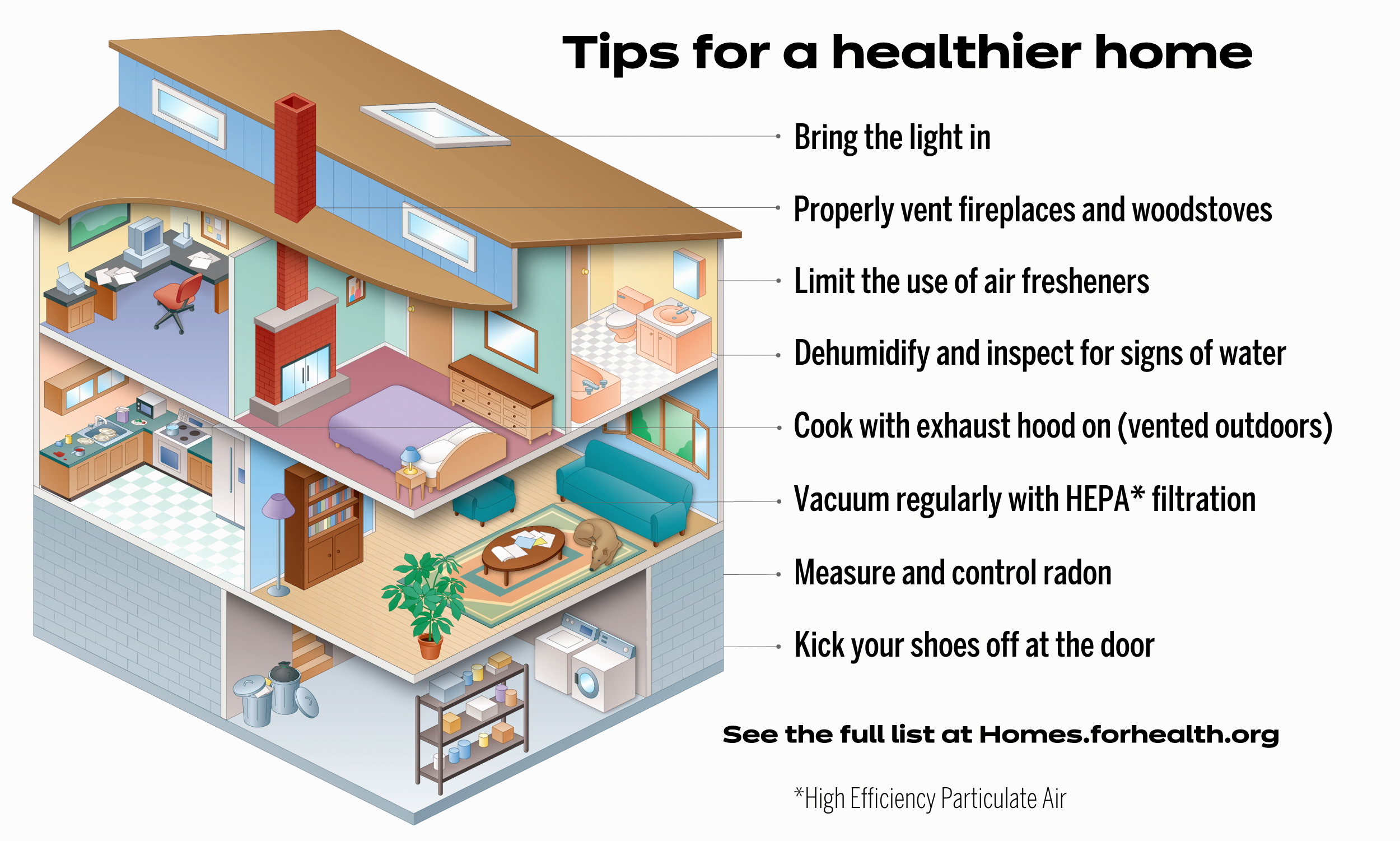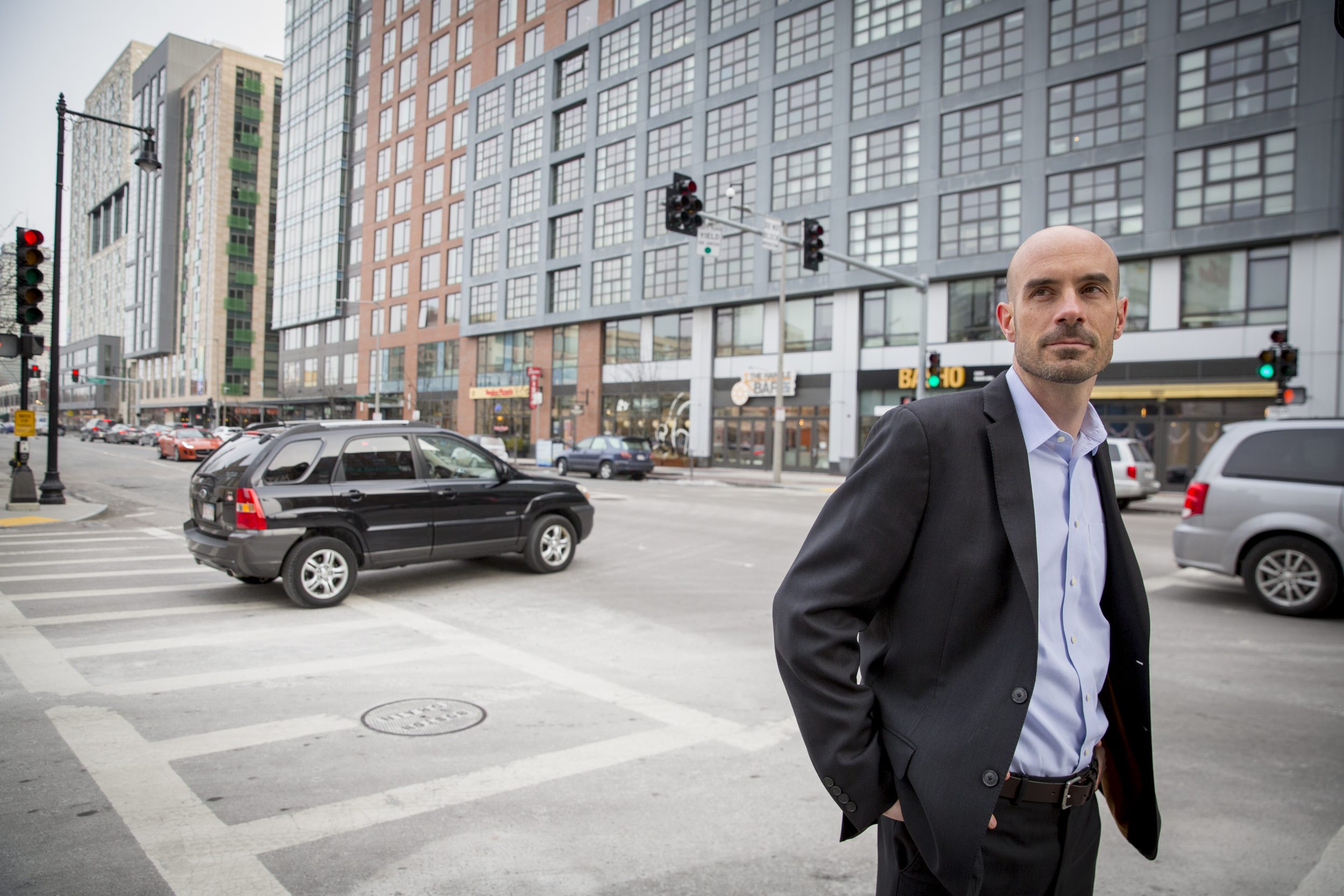
Illustration by Jennifer Maravillas
Is your home making you sick?
New report outlines tips for making your house a healthy one
Some of them we’ve likely heard before, some of them may be new, but all of them are meant to help us live longer, healthier lives in the places we spend 65 percent of our time: our homes.
In a recent report, researchers from the Harvard T.H. Chan School of Public Health have compiled 36 expert tips that help make your home a healthier place to live. And happily, most of them are quick fixes that can have a major impact on well-being.
“Home is where the heart is. It’s a figurative expression but it’s literal too because it’s actually where your heart is spending a majority of its time,” said one of the report’s lead authors, Joe Allen, who heads the School’s Healthy Buildings program. “The home influences heart health, brain health, hormone health, mental health, all these factors. We know what a healthy meal looks like. We know that exercise is good for you and that pollution is bad for you. But we know a lot less about the places where we spend all of our time.”
Through their work, Allen and his colleagues have been shining light on what a range of scientific research says about the home environment in the developed world. Much of it is cause for concern, such as the facts that vacuum cleaners without proper filters simply break dirt up into smaller particles and scatter them around the room; the average adult uses nine personal-care products each day, exposing him or her to 126 different ingredients; and cooking with poor ventilation can make kitchen air resemble that of a smog-filled city.
“When we cook most of us aren’t thinking that we are fundamentally changing the air quality inside our home, but making a meal can generate a lot of particles,” said Allen. (The Environmental Protection Agency defines particulate matter as matter containing microscopic solids or liquid droplets that are so small they can be inhaled and cause serious health problems.) “In your kitchen you can generate levels that look like a bad outdoor-air-pollution day in Beijing or Los Angeles, and depending on your type of ventilation, or if you don’t have an exhaust over your stove, those levels can get high and stay high.
“The science says you have to have an exhaust hood and it has to be exhausted to the outside,” he added, “otherwise, you are just collecting it and redistributing it somewhere else but not out of the house.”
The “Homes for Health” report offers tips for specific rooms, tips that apply to the entire home, and tips for outdoor areas such as yards and swimming pools. According to the research, one of the top ways people can make their homes healthier is by merely kicking off their shoes before they step inside. The move limits the amount of dirt and dust picked up from sidewalks, streets, and other places that harbor an alarming array of bacteria, germs, and chemicals that people bring indoors.

Source: Homesforhealth.org; image by Kenneth Batelman
“The reality is that we are tracking around everything on the bottom of our shoes,” said Allen, “so whatever you happened to walk through on the way into your home — if it’s soil, it can be pesticides, if it’s dirt and debris from the road, it can be lead — you are redepositing everywhere you go.”
For Allen, an assistant professor of exposure-assessment sciences, the room where we breathe one-third of the air we take into our lungs is of particular interest. “A full third of our life is spent in one room on this planet: our bedroom. When you talk about it that way, it changes your frame. Here’s a full third of your life in one maybe 12-by-12-foot box on planet Earth, and so it’s critically important.”
Research has repeatedly shown that getting enough quality sleep is key to overall health. Making sure the bedroom is well-ventilated by adding a humidifier or air purifier can help people breathe easier and healthier while they sleep. Keeping it cool is also key. Studies have shown that maintaining a bedroom temperature between 65 and 70 degrees leads to better sleep. And we’ve all heard the refrain “Don’t take your cell phone to bed with you.” There’s good reason. Not only is it a distraction that can keep your mind racing, but also its blue light causes the body to produce less melatonin, the hormone that helps regulate sleep and wake cycles. Warm light can help induce sleepiness, the report notes, and it suggests people leave their phones in another room and swap out their regular light bulb in favor of one with a dimmer that can be adjusted to achieve the warm light that can bring on the zzzs.
Keeping your place smelling nice is a priority for many homeowners, but those sweet-scented candles and air fresheners are likely doing more harm than good. The report urges people to limit their use of air fresheners that deliver a “constant stream of volatile organic chemicals,” into the air. Burning candles and incense is no better. Both involve combustion, a process that releases other harmful particulate matter.
“We know what a healthy meal looks like. We know that exercise is good for you and that pollution is bad for you. But we know a lot less about the places where we spend all of our time.”
Joe Allen (pictured below)

Rose Lincoln/Harvard file photo
“This report is a little bit of a call to action,” said Allen. “If you start gathering together all this buckshot evidence that exists in different indoor-air-quality journals, you can kind of piece together this big picture of what makes a home healthy, and we want people taking those next steps.”
The home guide follows two earlier reports released by the Healthy Buildings Program — “The 9 Foundations of a Healthy Building” and “Schools for Health: Foundations for Student Success” — that outline improvements to office and school indoor environments. Like those previous efforts, “Homes for Health” distills the science into easy-to-understand recommendations with links to peer-reviewed journal articles for those eager to dig deeper into the research and technical terms. Making his work accessible to a wide audience is something Allen considers key to his public health mission.
“People seem to be hungry for this kind of information, and so this is for everyone, everywhere,” he said. “It’s simple but not dumbed down. We have 36 expert tips that anyone can understand and read and implement in their home. That’s ultimately the goal.”








